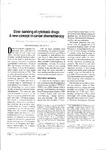Dose-Banding of cytotoxic drugs: A new concept in cancer chemotherapy
| dc.contributor.author | Sewell, GJ | |
| dc.contributor.author | Plumridge, RJ | |
| dc.date.accessioned | 2015-10-27T16:55:22Z | |
| dc.date.available | 2015-10-27T16:55:22Z | |
| dc.date.issued | 2001 | |
| dc.identifier.issn | 1079-2082 | |
| dc.identifier.issn | 1535-2900 | |
| dc.identifier.uri | http://hdl.handle.net/10026.1/3738 | |
| dc.description.abstract |
Doses of cytotoxic drugs have traditionally been calculated on the basis of body surface area (BSA), the only exception being carboplatin, for which the dose is calculated on the basis of renal function and targeted area under the plasma concentration–time curve. The use of BSA for dosage calculation arises from Phase I drug development, when animal doses are recalculated for humans on the basis of BSA. This practice has continued into the later drug development phases and, after marketing approval, into clinical practice.1,2 As a result, each dose of cytotoxic drug is individualized for each patient in accordance with current hematology test results and is usually prepared immediately before administration. The calculated dose may be rounded to account for the degree of accuracy possible with ampuls and vials. Individual preparation results in increased demand on pharmacy intravenous admixture and cytotoxic drug services, often causing delays for patients awaiting treatment; it can also disrupt scheduling, limit the number of patients hospital clinics can treat, and cause inefficiencies in the use of nursing resources. In response to the reactive nature of cytotoxic drug preparation and its consequences, a few hospitals in the United Kingdom have introduced “dose-banding” for a limited number of cytotoxic drugs. | |
| dc.format.extent | 1760-1764 | |
| dc.format.medium | ||
| dc.language | en | |
| dc.language.iso | en | |
| dc.publisher | Oxford University Press (OUP) | |
| dc.subject | Antineoplastic Agents | |
| dc.subject | Drug Labeling | |
| dc.subject | Neoplasms | |
| dc.subject | Quality Control | |
| dc.title | Dose-Banding of cytotoxic drugs: A new concept in cancer chemotherapy | |
| dc.type | journal-article | |
| dc.type | Article | |
| plymouth.author-url | https://www.ncbi.nlm.nih.gov/pubmed/11571821 | |
| plymouth.issue | 18 | |
| plymouth.volume | 58 | |
| plymouth.publication-status | Published | |
| plymouth.journal | American Journal Health-Systems Pharmacy | |
| dc.identifier.doi | 10.1093/ajhp/58.18.1760 | |
| plymouth.organisational-group | /Plymouth | |
| plymouth.organisational-group | /Plymouth/Faculty of Health | |
| plymouth.organisational-group | /Plymouth/REF 2021 Researchers by UoA | |
| plymouth.organisational-group | /Plymouth/REF 2021 Researchers by UoA/UoA03 Allied Health Professions, Dentistry, Nursing and Pharmacy | |
| plymouth.organisational-group | /Plymouth/REF 2021 Researchers by UoA/UoA03 Allied Health Professions, Dentistry, Nursing and Pharmacy/UoA03 Allied Health Professions, Dentistry, Nursing and Pharmacy MANUAL | |
| plymouth.organisational-group | /Plymouth/Research Groups | |
| plymouth.organisational-group | /Plymouth/Research Groups/Institute of Health and Community | |
| plymouth.organisational-group | /Plymouth/Users by role | |
| dc.publisher.place | England | |
| dcterms.dateAccepted | 2001-01-01 | |
| dc.rights.embargodate | 2023-10-11 | |
| dc.identifier.eissn | 1535-2900 | |
| dc.rights.embargoperiod | Not known | |
| rioxxterms.versionofrecord | 10.1093/ajhp/58.18.1760 | |
| rioxxterms.licenseref.uri | http://www.rioxx.net/licenses/all-rights-reserved | |
| rioxxterms.type | Journal Article/Review |


